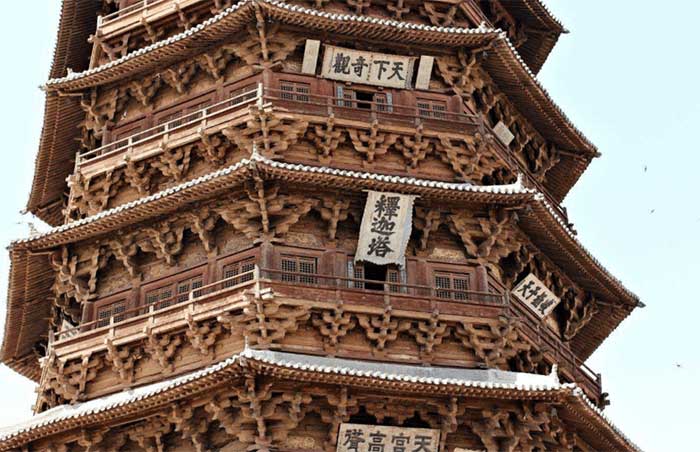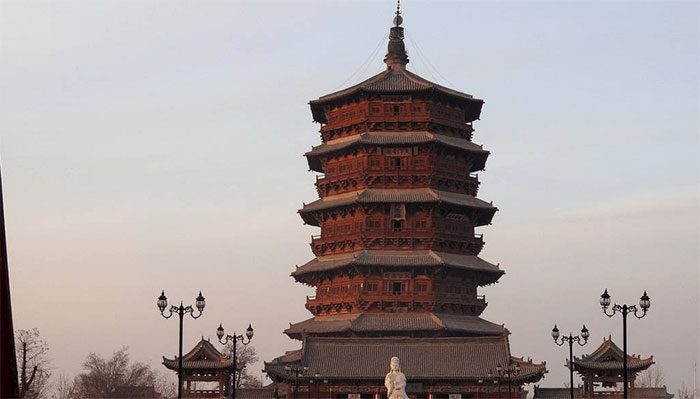Across the globe, we can find many beautiful religious buildings. However, in Shanxi, China, there lies a truly magnificent architectural wonder: a towering wooden pagoda that was constructed entirely without the use of nails. This pagoda not only boasts an astonishing height but also surprises visitors with its unique building techniques.
This pagoda is known as the Yingxian Wooden Pagoda (also referred to as the Yingxian Tower), located within the Fogong Temple, approximately 10 kilometers west of Yingxian County in Shanxi Province. Originally built in 1056 AD, it has a history spanning nearly a thousand years. This structure is not only the tallest and oldest wooden building in China but also the only large wooden tower in the world constructed entirely without nails or metal fasteners.

This pagoda is known as the Yingxian Wooden Pagoda (also referred to as the Yingxian Tower).
The wooden components are joined together using precisely shaped mortises and tenons, secured with wooden pegs. This mortise and tenon technique ensures the structure’s sturdiness and durability while contributing to its unique aesthetic beauty. The wooden elements are arranged and positioned logically, creating a gravitational balance for the entire structure. Thanks to this design, the Yingxian Pagoda can withstand the weight of the roof, snowfall, and even earthquakes.
The height of the Yingxian Wooden Pagoda reaches 67.31 meters, equivalent to a 20-story building, and features an octagonal design. Despite enduring numerous earthquakes and wars, this wooden pagoda remains standing, serving as a testament to the ancient Chinese craftsmanship in woodworking.
How did ancient Chinese craftsmen manage to construct such a tall wooden tower without modern tools and machinery? In fact, the artisans selected a high-quality wood known as hard fir. Hard fir is resistant to corrosion and easy to work with, making it a common material used in ancient buildings. Additionally, the wooden parts were joined using precisely shaped mortises and tenons, which were secured with wooden pegs instead of nails.
Mortise and tenon connections are an ancient technique that uses concave and convex parts of two or more components to link them together, forming a stable connection. This method of joining is both aesthetically pleasing and robust, capable of bearing greater loads. In the Yingxian Wooden Pagoda, craftsmen employed various mortise and tenon connection methods, including straight mortises, angled mortises, and concealed mortises, which contribute to the overall strength and stability of the tower.

The height of the Yingxian Wooden Pagoda reaches 67.31 meters.
The framework of the pagoda is made from large wooden beams, intricately joined together with complex mortise and tenon joints. These joints are crafted so precisely that no glue or nails are needed for stabilization. The Yingxian Pagoda features the typical architecture of Chinese Buddhist temples from that period, with three main halls: the Main Hall, the Avalokiteshvara Hall, and the Three Saints Hall. The halls are arranged along a central axis, creating an imposing and majestic appearance.
In addition to its superior construction technology, the Yingxian Wooden Pagoda holds profound cultural significance. Each floor of the tower is adorned with exquisite murals and Buddhist statues that reflect the social styles and beliefs of the time. These artworks not only showcase the artistic talent of ancient artisans but also provide essential insights for studying history and culture.
The Yingxian Wooden Pagoda in Shanxi, China, is a remarkable building that integrates engineering technology, art, and culture. It not only showcases the incredible skills of ancient Chinese woodworking but also represents the deep heritage of ancient Chinese culture.
As time has passed, the Yingxian Wooden Pagoda has faced several challenges. Due to the natural aging of wood and environmental factors, some cracks and erosion have appeared on the tower. To protect this invaluable cultural heritage, the Chinese government and relevant agencies have implemented a series of protective measures, including regular maintenance, monitoring, and research.

The Yingxian Wooden Pagoda is a remarkable building that integrates engineering technology, art, and culture.
The Yingxian Wooden Pagoda is not only a unique architectural work but also carries immense historical and cultural value. The pagoda is a testament to the creativity and exquisite construction techniques of ancient Chinese builders. It also serves as a spiritual tourism site attracting a large number of visitors, both domestic and international, each year.
At the same time, we should recognize that protecting cultural heritage is not just about repairing and preserving it but, more importantly, inheriting and promoting its cultural values. Therefore, we should utilize educational and popular science activities to increase awareness about the Yingxian Wooden Pagoda and appreciate its unique allure, aiming to better protect and inherit our cultural heritage.





















































